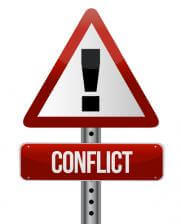How to Deal with Conflict by Using a Resolution Plan
Don’t let messy emotions get in the way. Get-It-Done Guy explains why creating a resolution plan in advance is the best way to deal with conflict.

We would all be logical and everyone would understand the best course of action (the one that I recommend, of course.) There would be no bickering or disagreement, and even art could be conveniently created according to the parameters considered most pleasing to the human nervous system. And we could use mathematical notation everywhere.
Sponsored by Boomerang: Conquer your Inbox! Get your free 60-day trial of Boomerang, the #1 Gmail service that millions of users rely on to stay on top of all their emails.
Manage Conflict in Advance
Since we’re stuck with emotion, though, the best we can do is learn to manage it in advance. The best way I know of managing conflict is to manage it when you’re calm and not in conflict mode.
Whether you’re in a relationship – or a workgroup, or starting a project, or doing a joint venture, or getting a new roommate or cubicle mate, or putting together a new team, or onboarding a new polyamorous family unit – it’s ideal to solve your conflicts in advance. When you’re all in a good mood, munching on gummy bears and exchanging back rubs, that is the time to resolve your conflict. You resolve it by creating a resolution plan.
Use a Resolution Plan
Normally, when you disagree, you have a mature, adult discussion. If things are thrown, they’re thrown at the wall, not at the other person. Then you offer a tantalizing piece of Oreo ice cream cake as a peace offering, and everything changes. By the end of the meeting, everyone happily jumps on the consensus bandwagon and life is perfect.
But what if the things you throw are sharp and pointed, and seem to be aimed at the other person’s head, rather than the wall? That’s a sign to activate your resolution plan.
Your resolution plan is what you all agree now you’ll do then to resolve a disagreement that’s so severe, it even resists Oreo ice cream cake.
Have a Safe Word
The first part of a resolution plan is a word or phrase you can say that lets everyone involved know that things are getting out of hand. You can yell, “Things are getting out of hand! Let’s use our resolution plan!” Or you can agree on a word or phrase that’s unlikely to come up in normal conversation, like “Perquackey.” Then when the action is nearing the boiling point, someone yells “Perquackey! Perquackey!” That’s the signal to switch to the resolution plan.
Breathe
Once someone calls out the safe word, everyone stops. You take a deep breath. Then wait 5 seconds. Then take another. Then wait 5 seconds. Then take a third deep breath. Then you de-escalate and begin resolution.
Flip a Coin
The simplest resolution plan is flipping a coin. If you agreed in advance that conflicts will be decided by a random coin flip, then after you call, “Perquackey,” you flip a coin and follow the desires of whomever wins the coin toss.
Let’s say that your schmoopie wants you to sell all your possessions to buy schmoopie a Liberace-style cloak for their birthday. You would rather keep your possessions and spend your money on a college degree. But you agreed back when you were both calm that your resolution plan would be to flip a coin. You flip. Heads. Schmoopie wins. You sell all your possession and schmoopie gets rhinestones. Lots and lots of rhinestones.
Use a Communications Framework
If you want to get more sophisticated, use a resolution plan that includes a conflict resolution process. For example, if you have read Getting to Yes, your resolution plan would include a discussion of positions and interests. Once the resolution plan kicks in, you each share your position and the underlying interest driving the position. Your position is saving money for college, and the underlying interest is saving for retirement, even though global warming will likely put your chosen retirement home 30 feet under water. Schmoopie’s position is wanting Liberace’s cloak, and the underlying interest is schmoopie’s desire to feel pretty, oh so pretty.
Now brainstorm together for solutions that meet both your underlying interests. You get the pathetic illusion of a secure future in what is really a cruel, uncaring world and schmoopie gets to feel pretty. You order a fake diploma off the internet, and schmoopie gets plastic surgery to look like Brad Pitt and Angelina Jolie.
Have a Trusted Third Party
Sometimes you really can’t reach agreement. Have the final step in your resolution plan be another person whose judgment both of your trust. Like, say, Grandma. When a conflict comes up, you each tell Grandma your side of the story and agree to abide by whatever Grandma decides. Since you trust Grandma to be fair, to consider the evidence, and to decide carefully, when Grandma listens to you both and then decides you’ll sell your possessions and sacrifice your college degree to buy schmoopie the cloak you promised, you follow Grandma’s instructions.
By agreeing in advance on who you trust, and agreeing to follow their advice, you assure that whichever one of you Grandma decides against will still go along with the decision. If Grandma is feeling feisty, the decision might be something completely novel, something that doesn’t correspond to either of your choices. Grandma is not required to consider any or all evidence in making the final decision.
Establish Resolution Incentives
Lastly, make sure the resolution plan provides incentives for you to follow it. Otherwise, when conflict hits, you’ll find some excuse not to follow the plan. You could sign a little agreement stating that if one of you refuses to follow the resolution plan, the offender has to fold the laundry for the week. Or to use positive motivation, you get rewarded for following the resolution plan with a new Pilot G-2 .7mm gel pen with navy blue ink for everyone who immediately jumps on board.
A resolution plan works because you all agree on it before a problem comes up, so your main motivation is creating a fair resolution process, not in proving any specific point. John Rawles would be proud.
You can create resolutions plans anywhere you will deal with the same people over a long period of time—in romantic relationships, at work, with your kids, and so on.
And those messy emotions? They will still happen, but now you’ll also have a cool, rational plan that you know will get you back on track.
For more tips on doing things better, check out get it done guy








